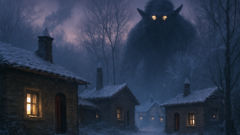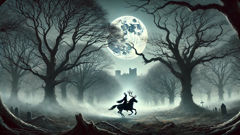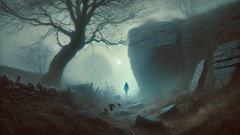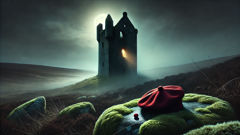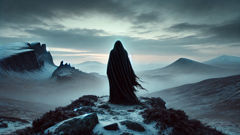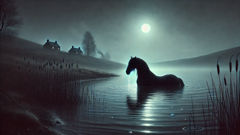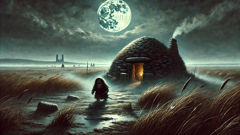Introduction
On the wind-lashed plains of Medieval Thrace, winter carried a sharpness that seemed to slice straight to the bone. Here, in a secluded Turkish village nestled at the edge of an ancient forest, traditions rooted deep in earth and memory offered the only warmth against the darkness. As December waned, a hushed anticipation swept over the stone cottages. The villagers—farmers, shepherds, bakers, and children alike—spoke in careful whispers, warning one another not to linger after dusk. For this was the time of the Karakoncolos, a brood of goblins dreaded above all else, believed to slither from the underworld during the twelve nights separating Christmas and Epiphany. It was said the Karakoncolos relished mischief: fouling wells, souring milk, and leading travelers astray in snow-choked woods. With shaggy black hair, hooves for feet, and eyes that glowed like embers, these fiends were glimpsed only by the unlucky or the doomed. Even the bravest men would not tempt fate with idle boasts or reckless laughter after sundown. Superstition ran like a current beneath every conversation, dictating customs both strange and sacred: children wore red ribbons to ward off goblin hands, doors were anointed with garlic and ash, and fires never died until dawn. It was more than caution—it was survival, woven into the rhythm of each winter night. The villagers' fear was not merely of tricks or inconvenience, but of something far deeper: the gnawing sense that the world was thinnest in these twelve nights, that unseen things might cross over and lay claim to mortal souls. In this charged atmosphere, a single spark—an unexplained shadow, a guttural laugh drifting from the dark—could ignite panic. Yet not all hearts in the village were ruled by dread. In a small cottage at the forest's edge, a young woman named Elif listened to her grandmother's warnings with curiosity and defiance. The old stories filled her with questions rather than terror, and she wondered whether courage—or perhaps kindness—might hold a power forgotten by those resigned to fear. As the longest nights drew near and the boundary between the human world and the realm of monsters blurred, Elif would discover that the legend of the Karakoncolos was more than a tale to frighten children. It was a test that would demand everything she had—and awaken an ancient hope buried beneath the snows of Thrace.
The First Night: Shadows in the Snow
Elif stood at the frost-veiled window, her breath fogging the glass as she watched the last villagers hurry home, hoods pulled tight against the cold. The sun had vanished behind tangled branches, and darkness seeped into every corner of the world. Her grandmother, Fatma Ana, moved about the cottage with silent urgency, placing bowls of honey and bread on the threshold, muttering ancient blessings under her breath. “The Karakoncolos are hungry tonight,” she warned. “If they find nothing to eat, they’ll turn their tricks on us.”
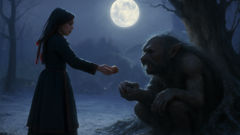
Elif smiled at her grandmother’s determination. Outside, the night air was thick with the scent of pine and woodsmoke, laced with a tension that made her fingers tingle. The villagers believed that the Karakoncolos roamed most freely on the first night—drawn by the taste of celebration lingering after Christmas feasts. The baker’s oven had cooled, and the church bells had long ceased, leaving only the sounds of the wind and the uncertain creak of tree limbs.
Elif’s father, Iskender, was last to return, stamping snow from his boots, his face drawn and silent. “No one should be out tonight,” he said, glancing at the door as though expecting claws to scratch at it any moment. He hung a sprig of garlic above the lintel and joined his family by the fire. They spoke little, each person lost in their own thoughts as shadows pressed against the walls. In a village where superstition was as real as the cold, silence was sometimes safer than words.
Hours passed. The fire’s glow flickered on Elif’s face as she fought drowsiness. Suddenly, a sound—half moan, half laughter—drifted from outside. The dog whimpered. Fatma Ana pressed a trembling finger to her lips. “Don’t answer, no matter what you hear,” she whispered. “Not until dawn.”
The noise swelled: heavy footsteps crunching in the snow, an unearthly giggle echoing through the darkness. Something rattled the shutters, then scratched at the door. Elif’s heart hammered. She peered between the curtains, glimpsing a shape that should not have existed—tall and hunched, matted hair gleaming with frost, its eyes burning with cold hunger.
Beside her, Fatma Ana began to pray. Iskender clutched an iron poker, his knuckles white. But Elif, curiosity outweighing fear, watched as the creature sniffed at the bread and honey left for it, then vanished into the trees. The villagers’ customs had worked—for now.
But outside, faint footprints circled every cottage. When morning came, milk had turned sour, tools were misplaced, and one of the baker’s finest loaves lay flattened in the snow. Whispers traveled quickly. The Karakoncolos had come, and they would return for eleven more nights.
Elif felt the change in the air. The village was quieter, faces tighter with worry. Children no longer played near the woods. The bravest men refused to hunt after sundown. Something about the encounter gnawed at Elif’s mind. She couldn’t shake the image of those glowing eyes and the odd, almost hopeful way the goblin had paused over their offering.
That night, Elif made her own preparation. She cut a length of crimson ribbon and tied it around her wrist—a charm against evil—and slipped from her bed as the household slept. Pulling on her thickest cloak, she tiptoed outside into the sharp night. Snow squeaked underfoot. She carried a lantern and a morsel of sweet bread, following the footprints she’d seen before.
Beyond the village, the forest loomed. Every tree seemed to bristle with menace. But Elif pressed on, heart pounding, until she reached a clearing lit by pale moonlight. There, hunched among the roots of an ancient oak, was the Karakoncolos itself. It looked up, startled—not by anger, but by surprise. Its features were strange: animal and human at once, with skin like bark and wild eyes that flickered between sorrow and mischief.
She swallowed her fear and set down the bread. The goblin sniffed the air, then took the offering with hesitant hands. For a moment, the world seemed to hold its breath. Elif realized that beneath its fearsome reputation, the creature was simply hungry, cold, and very much alone. She bowed and retreated, heart racing, leaving the goblin to its meal. That night, their cottage was spared any trouble.
Word spread quickly that Elif’s house had suffered no mischief. Some called her lucky, others foolish. Fatma Ana scolded her but watched her granddaughter with new respect. Elif wondered if there might be another way to face the Karakoncolos—something beyond fear and old rituals. As the second night approached, she resolved to learn more about these shadowy beings and the secrets hidden in the winter woods.
The Turning: Secrets Beneath the Ice
The second night brought a heavy snowfall that blanketed the world in white silence. Yet beneath that stillness, anxiety grew. Every villager had a tale: tools twisted out of shape, water barrels frozen solid despite being inside, dreams haunted by cackling voices and claws scraping against windowpanes. Fatma Ana’s warnings became more urgent. She urged Elif to stay indoors, but Elif’s curiosity now burned brighter than ever. It seemed to her that the Karakoncolos were not merely agents of chaos—they were bound to some deeper law, one the villagers had long forgotten.
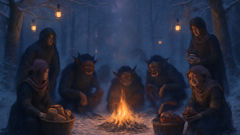
Elif spent her days listening to old stories and her nights watching the woods. She discovered that in distant villages, some believed the Karakoncolos had once been protectors, guardians who turned vengeful when neglected or disrespected. Others whispered that the goblins were cursed souls, doomed to wander until someone showed them kindness. Elif wondered: was it possible to break the cycle?
On the third night, Elif again ventured into the forest, carrying a lantern and a loaf sweetened with dried cherries—her grandmother’s favorite recipe. This time, she wasn’t alone. A pair of glowing eyes watched from the darkness, then another and another. Shapes flitted between the trees: not one Karakoncolos, but a dozen, each more fearsome than the last. They circled her in silence, their shaggy forms nearly blending with the shadows. Elif’s heart raced, but she stood her ground.
She spoke softly, offering the bread and asking for peace. One by one, the creatures approached, greedily devouring her gift. The largest—the same one she’d met before—stepped forward and pressed a cold clawed hand against her wrist. For a brief moment, images flashed before Elif’s eyes: fire and hunger, loneliness and longing, a great chasm opening beneath the earth and the Karakoncolos tumbling into darkness. She gasped, staggering back.
The goblin howled—a mournful, guttural sound that echoed through the trees. Elif understood, without words, that these creatures were trapped by their own legend. They haunted the twelve nights not by choice, but by ancient decree. Only an act of true compassion could free them.
The next day, she told Fatma Ana what she had seen. The old woman listened, her face drawn and serious. “Legends bind us, child,” she said. “But sometimes they can be changed.” Together, they devised a plan: on the seventh night—the midpoint of the haunting—the villagers would gather in the clearing and offer a feast, not out of fear, but as an act of forgiveness and hope.
Convincing the villagers was no small task. Many resisted, terrified at the thought of meeting the Karakoncolos face-to-face. But Elif’s courage inspired others. She spoke at the church, in homes, in the frosty marketplace. “We’ve tried fear for generations,” she told them. “Let’s try something else.”
As the seventh night arrived, every villager—old and young—made their way into the forest carrying baskets of food, lanterns, and trembling hope. Elif led the procession, her red ribbon now tied to a staff for all to see. The clearing glowed with firelight and anticipation. When the Karakoncolos emerged from the darkness, they found not cowering humans but a circle of warmth and welcome.
There was tension at first—a standoff charged with generations of suspicion. But when the goblins tasted the bread and honey, when they heard songs instead of prayers of warding, something shifted. The air grew lighter. The creatures danced in awkward joy, their howls softening into laughter. For the first time in living memory, the twelve nights passed with no mischief, no broken tools, no sour milk.
But not everyone in the village was ready for this change. A few elders grumbled that old evils could not be tamed. One man, suspicious and afraid, crept into the forest alone on the tenth night, planning to trap one of the Karakoncolos and prove their malice. He did not return by dawn.
The villagers searched for him, finding only his footprints circling endlessly in the snow, vanishing at the edge of a frozen pond. Elif was stricken with guilt, fearing that kindness had failed and that the old stories were right after all. But Fatma Ana comforted her: “Change is never without pain.”
On the twelfth night, Elif returned to the clearing alone. There she found the largest Karakoncolos waiting for her, sorrowful and silent. It handed her a small carved figurine—a token shaped like a human child. She understood: while some wounds take time to heal, the cycle had been broken. As dawn broke and Epiphany bells rang in the distance, the goblins melted away into mist. The legend had changed, and with it, the village found new hope beneath the winter sky.
Conclusion
The legend of the Karakoncolos lingered long after that fateful winter in Thrace. In years to come, villagers still spoke of goblins in hushed tones—but now their tales carried less terror and more wonder. Elif’s courage had rewritten not just a superstition, but the way an entire village faced its fears. The Karakoncolos were no longer faceless monsters lurking in the dark; they became reminders that compassion could outlast any curse. Each twelve nights, the villagers gathered not in dread but in celebration, sharing food and stories beneath the moonlit trees. Red ribbons and honey bread remained, but as symbols of hope rather than desperation. Children grew up hearing Elif’s story—how a single act of kindness bridged the gulf between worlds and turned shadows into allies. In Thrace’s long winters, where darkness pressed close and old legends still whispered from the woods, people remembered: even in the blackest night, empathy could light a way home. The boundaries between fear and hope, monster and human, grew softer, weaving a new tradition as enduring as the snow. And so the legend endured—not as a warning, but as a promise that light could always return, even when the world seemed lost to winter’s grip.

